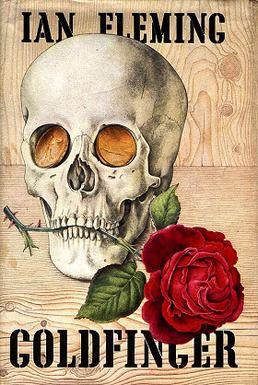
Ian Lancaster Fleming was a British writer, best known for his postwar James Bond series of spy novels. Fleming came from a wealthy family connected to the merchant bank Robert Fleming & Co., and his father was the Member of Parliament (MP) for Henley from 1910 until his death on the Western Front in 1917. Educated at Eton, Sandhurst, and, briefly, the universities of Munich and Geneva, Fleming moved through several jobs before he started writing.

Goldfinger is the seventh novel in Ian Fleming's James Bond series. Written in January and February 1958, it was first published in the UK by Jonathan Cape on 23 March 1959. The story centres on the investigation by the British Secret Service operative James Bond into the gold-smuggling activities of Auric Goldfinger, who is also suspected by MI6 of being connected to SMERSH, the Soviet counter-intelligence organisation. As well as establishing the background to the smuggling operation, Bond uncovers a much larger plot: Goldfinger plans to steal the gold reserves of the United States from Fort Knox.

Thunderball is the ninth book in Ian Fleming's James Bond series, and the eighth full-length Bond novel. It was first published in the UK by Jonathan Cape on 27 March 1961, where the initial print run of 50,938 copies quickly sold out. The first novelisation of an unfilmed James Bond screenplay, it was born from a collaboration by five people: Ian Fleming, Kevin McClory, Jack Whittingham, Ivar Bryce and Ernest Cuneo, although the controversial shared credit of Fleming, McClory and Whittingham was the result of a courtroom decision.

Aloisius Joseph Muench was an American prelate of the Roman Catholic Church. He served as Bishop of Fargo from 1935 to 1959, and as Apostolic Nuncio to Germany from 1951 to 1959. He was elevated to the cardinalate in 1959.

Rhonda Fleming was an American film and television actress and singer. She acted in more than 40 films, mostly in the 1940s and 1950s, and became renowned as one of the most glamorous actresses of her day, nicknamed the "Queen of Technicolor" because she photographed so well in that medium.

Rawhide is an American Western television series starring Eric Fleming and Clint Eastwood. The show aired for eight seasons on the CBS network on Friday nights from January 9, 1959 to September 3, 1965 before moving to Tuesday nights from September 14, 1965 until December 7, 1965, with a total of 217 black-and-white episodes. The series was produced and sometimes directed by Charles Marquis Warren, who also produced early episodes of Gunsmoke. The show is remembered by many for its theme song, "Rawhide".

Donald Denver Fleming was an American professional football player who was a safety for three seasons during the early 1960s with the Cleveland Browns of the National Football League (NFL). Fleming played college football for the Florida Gators, and thereafter, he played professionally for the Cleveland Browns of the NFL. His career was cut short by his accidental death by electrocution in 1963.
The 1959 NBA Finals, then known as the 1959 NBA World Championship Series, was the championship series of the 1958–59 National Basketball Association season, and was the conclusion of the 1959 NBA Playoffs. The best-of-seven series was played between the Western Division champion Minneapolis Lakers and the Eastern Division champion Boston Celtics. It was Boston's third trip to the NBA Finals and Minneapolis's sixth. This was the first Finals meeting in the history of the Celtics-Lakers rivalry, marking the start of the storied rivalry between the two franchises.

Willie Fleming is a former professional Canadian football player with the Canadian Football League (CFL)'s BC Lions. Fleming played collegiately as a halfback at the University of Iowa, where he was a member of the Hawkeyes' 1959 Rose Bowl championship team. He is a member of the Canadian Football Hall of Fame, the BC Sports Hall of Fame, and the BC Lions Wall of Fame. Fleming's number 15 jersey is one of eight numbers retired by the Lions. In 2003, Fleming was voted a member of the BC Lions All-Time Dream Team as part of the club's 50th anniversary celebration. In 2006, Fleming was voted to the Honour Roll of the CFL's Top 50 players of the league's modern era by Canadian sports network TSN.
Episcepsis is a genus of tiger moths in the family Erebidae. The genus was erected by Arthur Gardiner Butler in 1877.
The 1960 Rose Bowl was the 46th edition of the college football bowl game, played at the Rose Bowl in Pasadena, California, on Friday, January 1, 1960, at the end of the 1959 season. This was the first Rose Bowl appearance by the Huskies since 1944 and the first appearance by the Badgers since 1953. This was the first time these two football programs met on the field. The Washington Huskies defeated the Wisconsin Badgers, 44–8.
Episcepsis lenaeus is a moth of the family Erebidae. It was described by Pieter Cramer in 1780. It is found from Mexico to the Guianas.
Episcepsis melanota is a moth of the family Erebidae. It was described by George Hampson in 1909. It is found in Guyana.
Episcepsis phlebitis is a moth of the family Erebidae. It was described by Paul Dognin in 1913. It is found in Belize.
Episcepsis endodasia is a moth of the family Erebidae. It was described by George Hampson in 1898. It is found in Paraná, Brazil.

Episcepsis inornata is a moth of the family Erebidae. It was described by Francis Walker in 1856. It lives in Central America. It has also been seen in southern Texas.

Episcepsis thetis is a moth of the family Erebidae. It was described by Carl Linnaeus in 1771. It is found in Panama and Venezuela.

Episcepsis hypoleuca is a moth of the family Erebidae. It was described by George Hampson in 1898. It is found in Costa Rica.

The 1959 Rutgers Scarlet Knights football team represented Rutgers University in the 1959 NCAA University Division football season.
SS Walter L. Fleming was a Liberty ship built in the United States during World War II. She was named after Walter L. Fleming, American Civil War historian and Dean of the Vanderbilt University College of Arts and Science in 1923, and later Director of the Graduate School.











